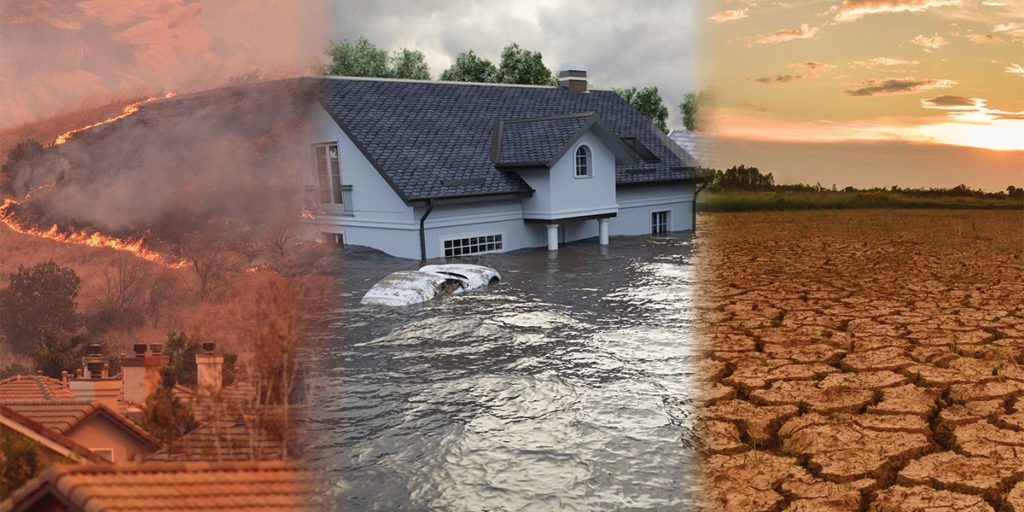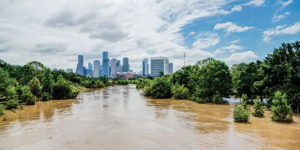
 By Deborah J. Cloutier, CRE® By Deborah J. Cloutier, CRE®President & Founder | RE Tech Advisors, Inc. |
This analysis was adapted and updated from the 2019-2020 Top Ten Issues Affecting Real Estate®, where “Weather and Climate-Related Risk” was ranked #3.
Many investors can no longer rely on historic performance to predict future returns. Climate risk has emerged as a new – and likely permanent – aspect of fiduciary duty and what it means to assess, disclose, and manage these risks for real estate investments. Increasingly, investors are demanding that climate risk be assessed and factored into future return projections and day-to-day decisions. One Counselor notes, “whether it is coming or not, it is affecting investment decisions.”
Weather and climate related events present physical and operational risks for property assets, both in terms of acute risk from hurricanes, flooding, wildfires, landslides, and extreme snowfall, but also chronic risks from sea level rise, drought, heat waves, water scarcity, and food security. For the real estate industry, these risks provide new opportunities and additional challenges. Many real estate owners and developers are adapting by hardening assets, strengthening emergency preparedness plans and strategies, moving mechanical systems to higher floors, installing backup generators, sea walls and berms, and calculating the ROI of on-site renewables and battery storage.
Even if a property isn’t exploring or implementing adaption and resiliency strategies, they are surely relying on insurance as a strategic response to climate risks. The National Center for Environmental Information (NCEI) is the Nation’s scorekeeper of the economic impact of weather and climate data. According to NCEI, the average insured loss per year for 1980 to 2018 was $19.3 billion. But the frequency and intensity of weather events are increasing. During 2017, the U.S. was impacted by 16 separate billion-dollar events – resulting in the largest, most expensive year in recorded history for weather and climate related insurance losses, costing the U.S. more than $300 billion. In 2018, the U.S. also experienced the 4th highest total costs ($91.0 billion). The combined costs of the 2018 disasters trails only the years 2017 ($312.7 billion), 2005 ($220.8 billion) and 2012 ($128.6 billion) when all years are inflation-adjusted to January 2019 dollars.
As one Counselor astutely says, “Our cities will survive Trump, Brexit, and even another downturn, but we cannot continue to have Houston-like events and pretend this won’t impact our industry.”
Since 2008, the volume of property and causality premiums written increased over 33%. The 2018 insurance losses for California topped $12 billion following the deadliest and most destructive wildfires in a century. More than 13,000 insured homes and businesses were destroyed out of more than 46,000 claims reported by insurers.
Midwest flooding recently prevented farmers from planting crops, and there is much discussion about how weather is likely going to affect farmer yields this year.
Following climate-related events, property valuations are taking a big hit. An analysis of NCREIF and National Hurricane Center data found that for all property types, the hurricane decreased values by almost 6 percent one year after the storm occurred, and the negative effect was even greater two years out with a startling 10.5 percent valuation decrease.
As a Counselor warns, “Insurance will be unable to deal with the risk, and costs will rise sharply. Insurance will no longer be available for certain types of risk. Costs to remediate effects of rising sea levels will be astronomical.” Further, insurance has its limitations as a response strategy. While properties can be insured against the actual damage from a climate event such as hurricane, it can’t address the loss in value due to changes in the supply and demand for space in that market.

Flooded Bayou River after Hurricane Harvey in 2017. Photo: Trong Nguyen/Shutterstock.com
Additionally, there are also transitional risks associated with climate, especially that of policy and legal risk, technology risk, market risk, and reputation risk. One Counselor expresses concern regarding “our general unpreparedness” as an industry by saying, “the associated risks of climate change will be a game changer for our industry and we are not prepared to integrate these new risks into our standard business processes for due diligence, operations, valuation, and sale.”
The Counselors correctly observe that climate change is driving a host of new building laws and ordinances that owners and operators need to quickly come up to speed. Twenty-nine cities and two states now require building laws that range from mandatory energy and water benchmarking to ambitious climate goals. Public and private buildings must be made dramatically more energy efficient. For example, in Washington D.C. the Clean Energy DC Omnibus Act focuses on energy reductions with performance targets that must be met, where New York City’s Local Law 97 focuses on carbon reductions, setting annual carbon intensity limits on building emissions, including emissions from electricity consumed by buildings 25,000 square feet and larger. In D.C., the rulemaking process will define the details of compliance, whereas New York City’s Local Law 97 already spells out carbon intensity limits that will effectively require improvements by the bottom 20% of worst performing buildings in the initial 2024-2029 compliance period. In order to comply with these laws and maintain projected returns, property owners and investors have a new set of rules to understand and strategic responses to be developed.
Responding to greater market awareness of these risks, investors and stakeholders are increasingly pushing for more actionable information and greater transparency. In particular, the Financial Stability Board (FSB) Task Force on Climate-Related Financial Disclosures (TCFD) seeks to stimulate market dialogue and increased transparency on climate-related risks by providing information to investors, lenders, insurers, and other stakeholders, encouraging investment managers to align their disclosure with investors’ needs. As of February 2019, over 580 companies, responsible for over $100 trillion of assets, have expressed support for the TCFD recommendations and are working to assess and integrate climate-related risk in upcoming company disclosure.
One way investors can rank and compare real estate fund performance is through the proliferation of more than a dozen voluntary reporting frameworks. These frameworks have emerged to evaluate, validate, score and provide business intelligence on Environmental, Social and Governance (ESG) aspects of sustainability. Among these frameworks, the Global Real Estate Sustainability Benchmark (GRESB) is uniquely designed as an ESG benchmark for listed property companies, private property funds, developers, and investors that invest directly in real estate. In 2019, more than 1000 property companies, real estate investment trusts (REITs), funds and developers surveyed over 100,000 assets across 64 countries that represent more than $4.1 trillion in gross value. More than 100 institutional investors, collectively representing over $22 trillion in institutional capital, used GRESB data and rankings in investment decisions.
This is really just the tip of the proverbial iceberg, with many additional implications for real estate. From building certifications and rating systems, to new underwriting and lending products, to more stringent building codes and standards, to an already strained and antiquated infrastructure, investors and policy maker’s response is having a dramatic and indelible mark on the real estate industry. Climate related risks are deeply interconnected to other top issues on the 2019-2020 Top Ten Issues Affecting Real Estate®, including political divisions, infrastructure, affordability of housing, and investor confidence. •


